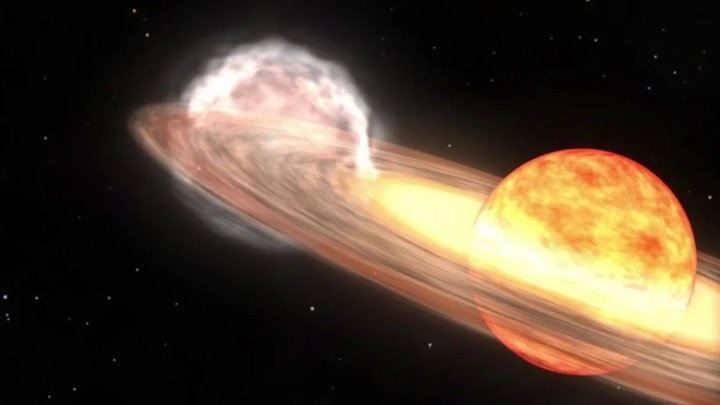
The night sky will soon be getting a brand new star when an expected cosmic explosion that will be visible from Earth even with the naked eye occurs this summer. It is the result of a phenomenon called a nova, where a binary star system called T Corona Borealis (T CrB) will explode in a flash of light that will take it from its dim form, currently visible only with a telescope, to a bright dot visible overhead.
A nova eruption happens in binary systems where two stars orbit each other. In the case of T Corona Borealis, the pair consists of a large dim star called a red giant and a smaller, but much denser star called a white dwarf. The white dwarf is the core left behind of what was once a star like our sun, and its density means it has strong gravity that allows it to eat away material from its companion.
“The ultra-dense white dwarf can steal material from the companion star in a process known as accretion, causing a layer of hydrogen to build up on the white dwarf surface,” explains astronomer Mark Hollands from the U.K.’s University of Warwick. “Once sufficient material has built up, this layer will reach a critical temperature, igniting hydrogen fusion. This powerful nuclear detonation ejects the gas from the white dwarf surface in a hot luminous shell. What we then see is the system becoming thousands of times brighter and is responsible for the observed nova.”
Typically, these nova explosions happen just once and are hard to predict. This system, though, is unusual it in that it erupts repeatedly, around every 80 years.
Astronomers have already observed telltale dips in the brightness of the system, and they expect the nova to occur within the next few months. Once the eruption happens, it should be easy to spot in the sky.
“The best thing you can do now is to get familiar with the patch of sky around the constellation Corona Borealis, using a star chart or phone app,” Hollands said. “Once you get to know what stars are visible in that part of the sky, you’ll really appreciate the difference when one night in the next few months there is one extra member of the constellation. The nova will be visible to the naked eye for a few nights and reach a similar brightness to other stars in the Corona Borealis constellation, but if you miss that window, it’ll still be visible for a few weeks with a good pair of binoculars.”
Editors’ Recommendations
Services Marketplace – Listings, Bookings & Reviews
